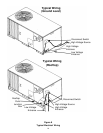
9
Transportation Damage
All units are securely packed in shipping cartons ap-
proved by the International Safe Transit Association. The
carton should be checked upon arrival for external dam-
age. If damage is found, a request for inspection by car-
rier agent should be made in writing immediately.
The unit should be carefully inspected upon arrival for
damage and bolts or screws which may have loosened
in transit. In the event of damage, the consignee should:
1. Make notation on delivery receipt of any visible dam-
age to shipment or container.
2. Notify carrier promptly and request an inspection.
3. In case of concealed damage, carrier should be no-
tified as soon as possible-preferably within 5 days.
4. File the claim with the following supporting docu-
ments within the 9-month statute of limitations.
a. Original Bill of Lading, certified copy, or indemnity
bond.
b. Original paid freight bill or indemnity in lieu thereof.
c. Original invoice or certified copy thereof, showing
trade and other discounts or reductions.
d. Copy of the inspection report issued by carrier
representative at the time damage is reported to
the carrier. The carrier is responsible for making
prompt inspection of damage and for a thorough
investigation of each claim. The distributor or
manufacturer will not accept claims from dealers
for transportation damage.
NOTE: When inspecting the unit for transportation dam-
age, remove all packaging materials. Follow local codes
when disposing or recycling the packaging material.
Locating The Thermostat
The thermostat should be mounted 5 feet above the floor,
on a vibration free inside wall in a room or a hallway that
has good air circulation.
Movement of air should not be obstructed by furniture,
door, draperies, etc. The thermostat should not be
mounted where it will be affected by drafts, hot or cold
water pipes or air ducts in walls, radiant heat from fire-
place, lamps, the sun, television, etc. Consult the In-
struction Sheet packaged with the thermostat for mount-
ing instructions.
All units have one stage of heating and one stage of
mechanical cooling. Units which will have economizers
may use thermostats with one or two stages of cooling.
IV. Rigging and Handling
CAUTION
To prevent possible property damage, the
unit should remain in an upright position
during all rigging and moving operations.
To facilitate lifting and moving when a
crane is used, place the unit in an ad-
equate cable slide.
Important: If using bottom discharge with roof curb,
ductwork should be attached to the curb prior to install-
ing the unit. Ductwork dimensions are shown in Amana
Roof Curb Installation Instructions.
Refer to the Amana Roof Curb Installation Instructions
for proper curb installation. Curbing must be installed in
compliance with the National Roofing Contractors As-
sociation Manual.
Lower unit carefully onto roof mounting curb. While rig-
ging unit, center of gravity will cause condenser end to
be lower than supply air end.
If using a fork lift, see Figure 2 for location of fork prongs.
Make certain prongs support unit weight.
Figure 2
Rigging


















